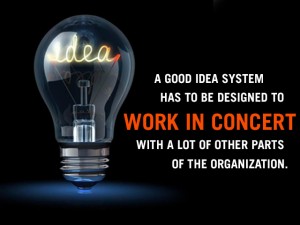Sometimes, as a consultant, your client does not follow your advice. When setting up and launching a high-performing idea system, many leaders want to work on their organization’s culture first, before launching their idea system. They want to lead with the culture – that is, make the idea process voluntary and encouraged, and not part of the required work – in the hopes that when the culture “takes”, the ideas will naturally follow.
This is a flat-out mistake. At the very least, it will take much longer for your idea system to gain traction, but more likely you will cause it to fail.
The problem is that an organization’s “culture” is nebulous and hard to measure, so it is hard to get handle on how to change it. I could write a book about all the culture-changing efforts I have watched fail over the years because they were scattershot and based on bad data, or no data at all.
Right out of the blocks, an idea system gives you something very tangible to manage. You can see very clearly how many ideas each supervisor and manager is getting and implementing in his or her area, and you can observe their idea meetings directly.
As long as you follow through on the qualitative and quantitative information you get by tracking and observing your idea teams, you will know exactly what kind of help each supervisor and manager needs to lead a more improvement-oriented group. You will find what you perhaps already knew – that some people you have in positions of responsibility don’t belong there, but this time you know why and have the information to take action.
You will also know exactly what roadblocks your teams are facing as they try to implement their ideas – that is, which corporate policies and management systems are discouraging or blocking ideas. You will have no shortage of “to-do” items, each of which will improve your corporate culture as you lift them, and will help to get ideas flowing.
We have watched a great many leaders hope that their idea systems will be saved as the culture changes, only to be disappointed, when it doesn’t. Once you have started an idea system, you have only a relatively short window to get it right, and you can wait a long time for a culture shift to happen. Once managers and employees get used to a relatively low level of idea activity in the system, it is hard for leaders to recover.
But once managers and employees get their feet wet, and see that the ideas are only helping them work better, a virtuous cycle is created. Ideas lead to more ideas, which lead to a better culture, which leads to more ideas, and so on.
As Ray Winter, then President of BIC Corporation, once observed to us about the effect of his company’s idea system on his company’s culture, “This system has taught my managers real respect for their employees. My managers have learned that their employees can make them look awfully good, if they only let them”.
Managers and leaders who go gently in the beginning, hoping they can change their culture before getting serious about ideas only create more work for themselves, or set themselves up for failure, in the end.
As with so many things, you need to jump in with a good plan, learn along the way, and just make the idea system work. As the leaders of many idea-driven organizations will tell you, the culture will follow along very quickly.


